Distortion pedals are a staple in the toolkit of many guitarists, providing a means to craft the gritty, aggressive tones that have defined countless genres of music. These compact devices shape the sound by amplifying a guitar’s signal until it distorts, resulting in a warm, fuzzy, or crunchy sound characteristic of rock, metal, and blues music. Some of the best distortion pedal options can breathe new life into a guitar rig, giving a musician the ability to express different moods and styles.
When shopping for one of these FX pedals, it’s essential to consider the type of sound you’re after. The market offers a wide range of pedals, from vintage-flavored warmth to modern high-gain brutality. The pedal’s circuit design, such as analog or digital, also affects tonal qualities and responsiveness. Additionally, the build quality and the presence of tone-shaping features like EQ controls are crucial for fine-tuning your sound and ensuring the pedal’s longevity on a rigorous touring schedule or within a studio setting.
We understand the importance of finding a distortion pedal that not only meets a guitarist’s sonic preferences but also fits seamlessly into their existing setup. During our evaluation process, we pay special attention to the pedal’s versatility, ease of use, and how well it interacts with different amplifiers and guitars. The goal is to identify pedals that deliver a consistently great tone and inspire creativity.
Our rigorous testing process for distortion pedals involves evaluating their performance across various styles and gear configurations. By pushing these pedals to their limits, we ascertain which ones stand out in terms of tone quality, dynamic response, and user-friendly operation. Our findings are poised to guide you to the distortion pedal that will unlock new dimensions in your music.
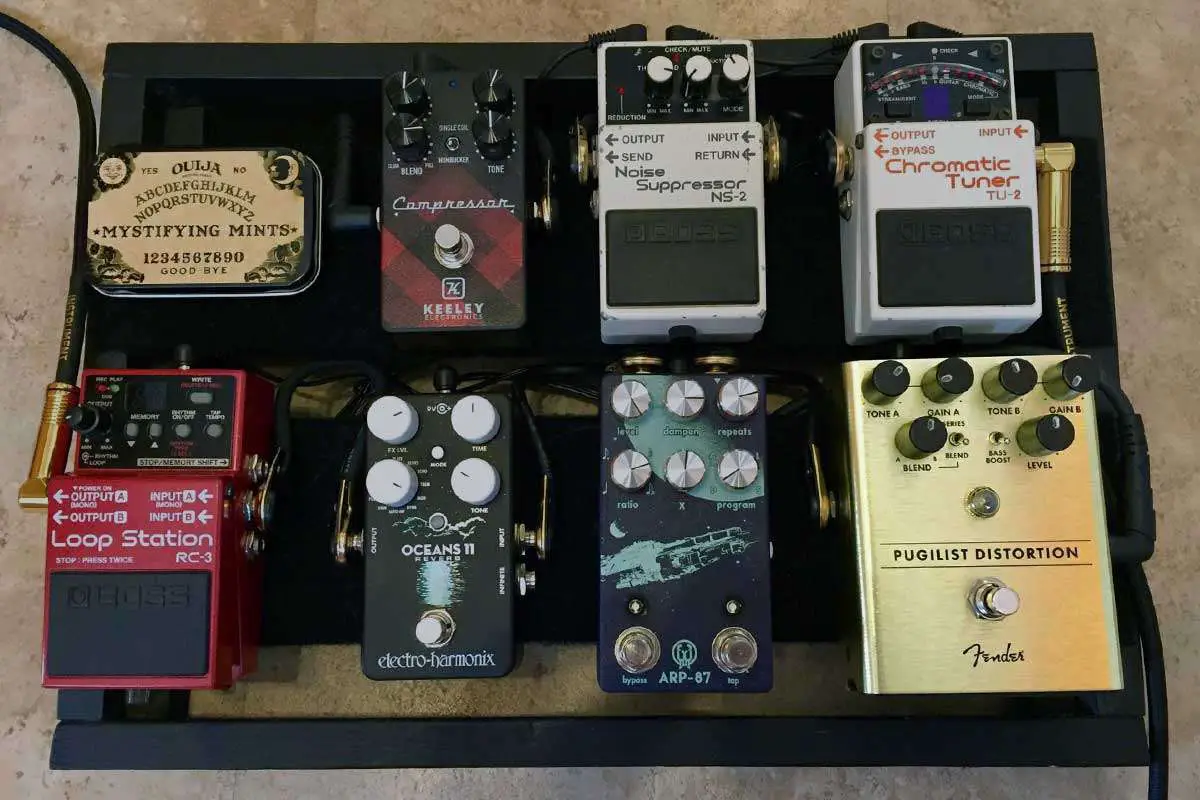
Top Distortion Pedals
In our search for the best distortion pedals available, we’ve meticulously tested and compared an array of models to find those that truly stand out. Our focus is on sound quality, build, versatility, and value to ensure that every pedal we recommend meets a high standard of excellence. Whether you’re a seasoned guitarist looking for a specific tone or a newcomer eager to experiment, our curated selection aims to cater to a wide spectrum of needs and preferences.
Fender Pugilist
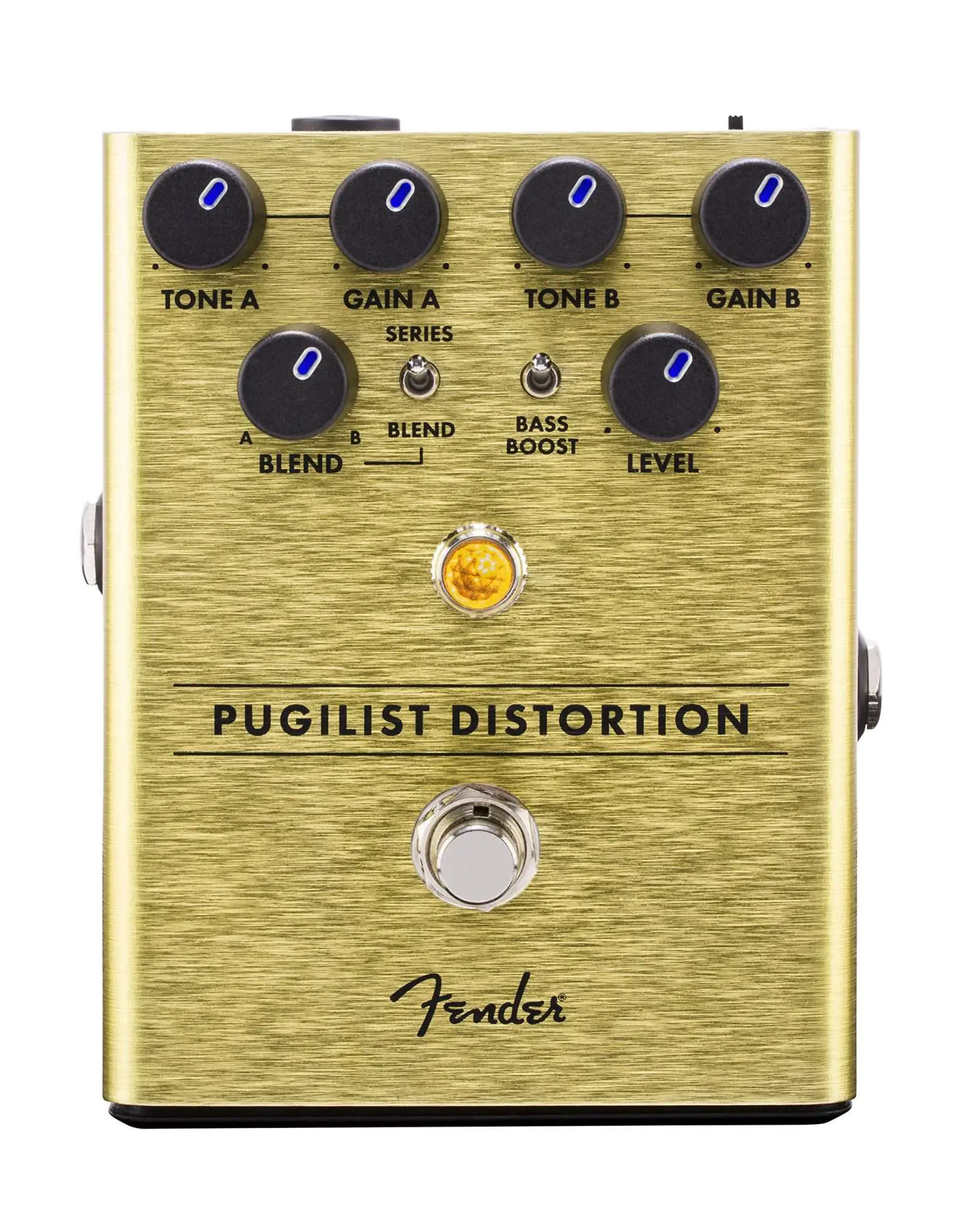
We found that the Fender Pugilist shines in its ability to shape distinct distortion flavors, perfecting both stage and studio performances.
Pros
- Dual gain engines offer versatile distortion sounds
- Discrete tone controls provide precise sound shaping
- Backlit knobs and unique design add a touch of class to your pedalboard
Cons
- Might not suit those seeking extremely high-gain or metal tones
- Dual gains can lead to feedback in high volume settings
- Some users reported issues with the pedal input during heavy use
Playing around with the Pugilist, its heavy and fiery sound adds significant weight to any guitar rig, ideal for a musical heavyweight. With independent control over each gain engine, the pedal lets you sculpt your sound precisely. Whether stacking channels for a cascading, complex distortion via the Series/Blend switch or fattening up tones with the bass boost, we appreciated the control at our fingertips.
Engaging the pedal immediately transforms your clean tone into a gritty, character-rich sound. From light overdrive to heavier crunch, it’s gratifying to navigate through varying degrees of distortion, all without losing clarity. The pedal’s backlit knobs aren’t just for show; in low-light scenarios, these indicators are a practical feature we didn’t know we needed until we used it.
We played with the blend control extensively, mixing the two channels to discover a sound unique to our style. This level of customization is a strong feature, as it means the Pugilist can adapt to our ever-evolving playing. And while robustness is a hallmark of Fender’s craftsmanship, some of us experienced connectivity issues during rigorous use, which is worth considering if you’re planning to go all out on stage night after night.
Boss MT-2 Metal Zone
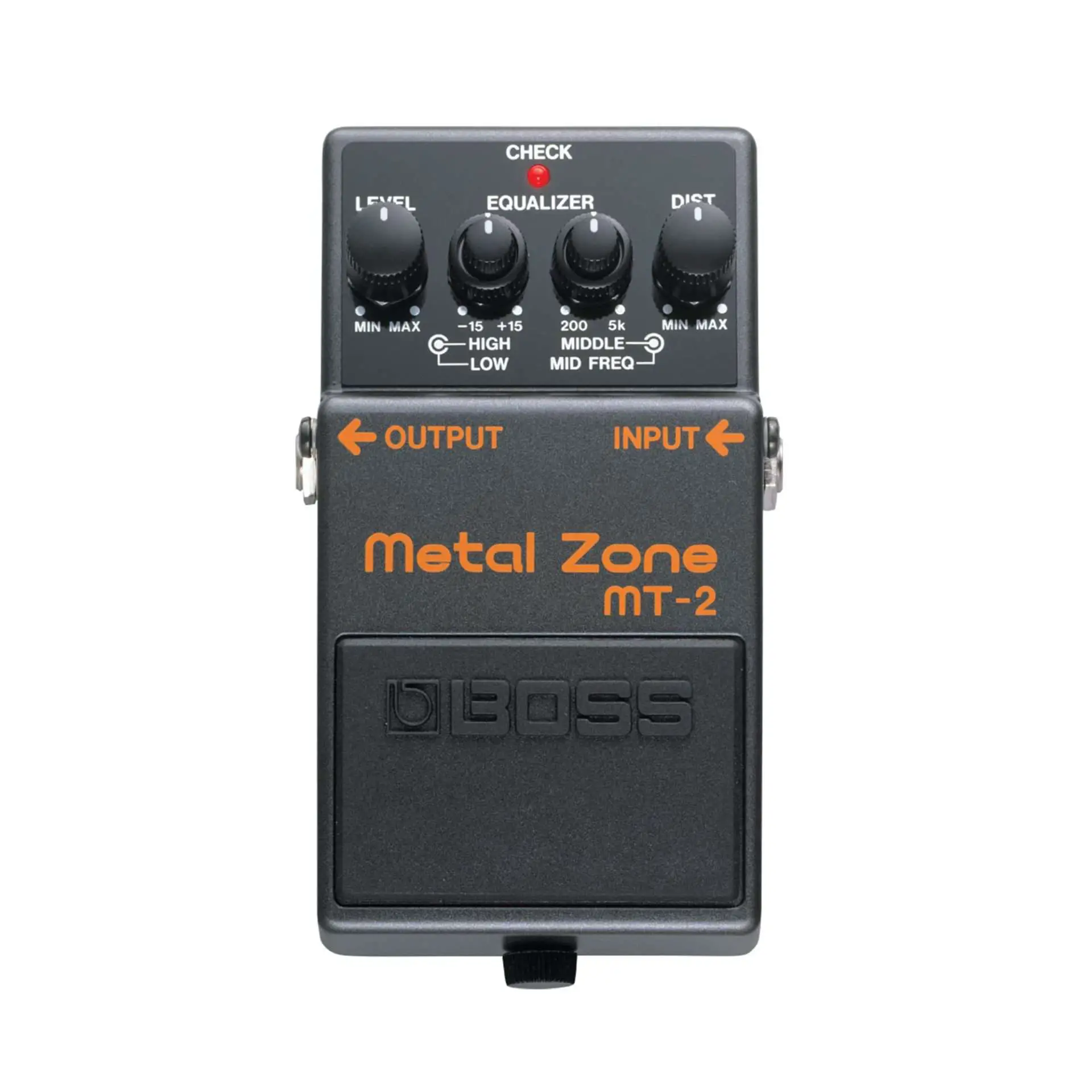
We think guitarists seeking a versatile distortion pedal with substantial gain should consider the Boss MT-2 Metal Zone.
Pros
- Thick, tight distortion and sustain
- Gets great tones at various volume levels
- Extremely suitable for metal and hard rock genres
Cons
- Can be overly saturated for lighter music styles
- Some may find the sound too aggressive
- Does not include a DC adapter
When we stomped on the Boss MT-2 Metal Zone, the first thing we noted was its monster high-gain performance. This pedal is like a warrior in battle, never flinching as it roars through heavy rhythms and intricate solos. We were able to extract some seriously meaty tones ideal for metal and hard rock enthusiasts.
The MT-2’s dual-gain circuitry almost feels alive, responding dynamically to pick attack and nuances in our playing. We observed its ability to produce endless sustain that will please shredders and solo artists aiming to stand out in the mix.
Adjusting the pedal’s EQ delivered a wide tonal palette which surprised us; from brooding lows to screaming highs, this little box pushed the frontiers of what we thought a single pedal could do. However, we did notice that achieving more conservative distortion levels might be a slight challenge for those looking for subtlety.
In our experience, while the Metal Zone is overwhelmingly celebrated for its rich, aggressive distortion, it’s not without its drawbacks. It didn’t include a power adapter, and the onboard tone can be too intense for genres outside metal and hard rock. Still, if you play these styles, it’s a small price to pay for such authoritative sound sculpting capabilities.
Boss DS-1 Distortion

We find the Boss DS-1 to be an excellent choice for musicians seeking that classic distortion tone on a budget.
Pros
- Delivers the iconic BOSS distortion sound, versatile for guitar and keyboard.
- Responsive to playing dynamics, allowing nuanced expression.
- Comes bundled with essential accessories, perfect for gigging musicians.
Cons
- Limited to one style of distortion which may not suit all genres.
- The included cables are of basic quality, might need upgrading.
- Requires a separate power supply purchase for optimal use.
Our experience with the Boss DS-1 Distortion has been largely positive. After hooking it up, we were pleased with the simplicity and user-friendly interface. The knobs for distortion, tone, and level are intuitive and offer a decent range of sound customization. There’s something satisfying about the way it handles the nuances from soft to heavy playing, adding a charismatic touch.
The pedal has a solid build that feels reliable during live performances. We’ve stomped on it numerous times and it’s withstood the rigors of transport to gigs and rehearsals without a hiccup. It doesn’t just offer robustness; its distortion is assertive and shapes the sound distinctly, fitting in well with various musical styles.
In terms of accessories, the bundle carries good value. While the cables do their job, those seeking the highest fidelity might look at higher-grade options eventually. Yet, for someone just starting out or looking to expand their pedal board without breaking the bank, this set is hard to beat.
When it comes to power, keep in mind that this pedal does not come with a power supply. Battery life is adequate, but for long sessions, we recommend purchasing a power adapter, which ensures uninterrupted creativity.
Overall, the Boss DS-1 Distortion bundle is a straightforward, reliable companion that provides that sought-after distortion with a characteristically gritty edge. It’s a staple for our gear collection, and we find it an unfailing ally in crafting our sound.
The RAT2

We’ve found that if you’re aiming for that classic rock grind or a boost for your solos, the RAT2 could be your go-to pedal.
Pros
- Produces versatile, robust distortion tones perfect for rock
- Offers an incredibly sweet spot for overdrive with tube amps
- Enhances live solos with a distinct volume boost
Cons
- May be too aggressive for those seeking subtle distortion effects
- Lacks the modern features some newer pedals offer
- The compact design might be cramped for those who prefer larger footswitches
First strum through the RAT2 and you’re transported to a world of vintage grit and soaring leads. There’s an unmistakable edge to its character that breathes life into any guitar rig. On stage, when the amp needs to cut through the mix, this stompbox boosts the signal with ease, making solos stand out with crisp precision.
At home or in the studio, its simplicity is a boon. A few tweaks are all it takes to go from a dirty blues shuffle to a hard-hitting rock anthem. The RAT2 isn’t just another distortion pedal – it’s a reliable workhorse that has just been road-tested all over again.
Toying with the RAT2 brings a revelation: it’s not about the number of knobs or switches; it’s about the sound. And the sound speaks volumes. For those of us chasing that nostalgic rock tone, the RAT2 delivers in spades, serving up a banquet of aural delight that’s as gritty as it is graceful.
Donner Morpher Distortion

If you’re aiming for that 80s metal crunch or tight distortion in your guitar sound, the Donner Morpher is an absolute must-try.
Pros
- Versatile distortion with three distinct modes
- Sturdy build that can handle rigorous use
- True bypass maintains a clean signal when disengaged
Cons
- May require an additional power supply purchase
- Might be too specific for those who prefer soft overdrive
- Limited tonal shaping without an EQ
We grabbed the Donner Morpher Distortion recently, and its effect on our guitar tone was impressive. The pedal churns out high-gain distortion with ease, allowing us to tap into an aggressive sound spectrum that’s perfect for genres like hair metal or even more modern metal styles.
Handling the Morpher, we were struck by its solid aluminum-alloy construction – this pedal is built like a tank! Its compact design doesn’t hog pedalboard space. The sleek red casing is as durable as it is attractive, making it a reliable gigging companion.
One of the Morpher’s standout features is its true bypass circuitry, ensuring that once switched off, it leaves our guitar’s natural tone uncolored. We’ve been through plenty of sessions with different effects, and it’s refreshing when a pedal keeps things noise-free like this one does.
Behringer OD300
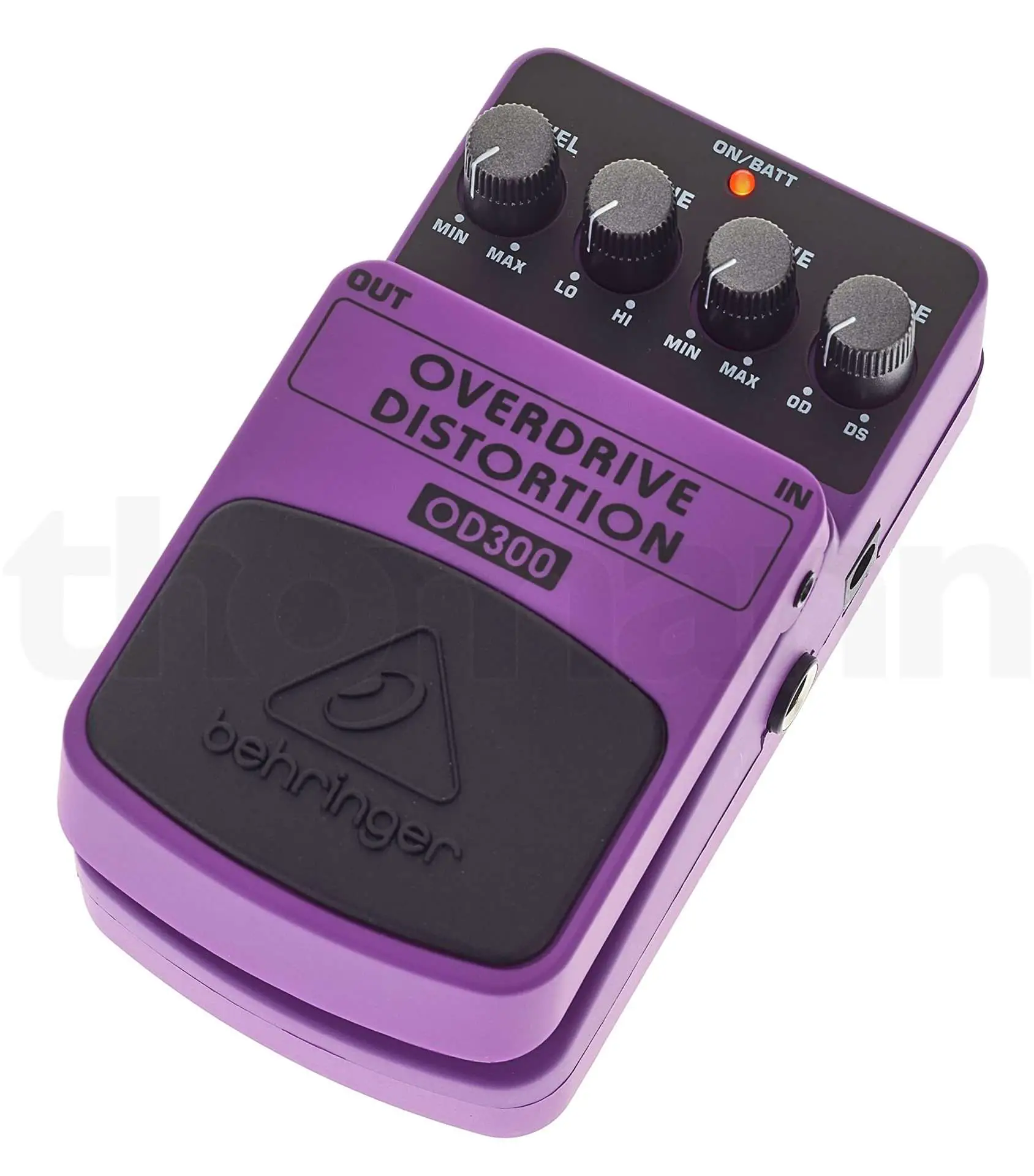
If you’re looking to ignite your sound with both overdrive and distortion without breaking the bank, the Behringer OD300 might just be your ticket.
Pros
- Versatile effects range with the ability to blend overdrive and distortion
- Intuitive controls for easy sound shaping
- Exceptional value for the features offered
Cons
- Plastic housing may not withstand heavy stomping
- Lacks a power supply; battery installation can be fiddly
- Some users report a buzz or muddy tone at certain settings
Having recently had a session with the Behringer OD300, we’ve come away quite impressed by its versatility. The blend of overdrive and distortion is seamless, and tailoring the sound is straightforward with the dedicated controls. It definitely provides a wide spectrum of tonal possibilities, from a light, bluesy overdrive to a more aggressive distortion suited for rock and metal.
The pedal’s design is compact, and it fits snugly among other effects on our pedalboard. While the construction is primarily plastic, it has so far held up to our regular in-home jam sessions and rehearsals. The power flexibility means you can use it with a standard 9V battery or plug it into a power supply, allowing you to adapt based on your setup circumstances.
Our hands-on use highlighted a notable performance at this price point. The OD300 delivers on its promise of dual effects in a single pedal, giving you the ability to craft your signature sound without emptying your wallet. It’s our opinion that for bedroom players and those just starting out, this pedal offers a lot of bang for the buck. However, for gigging musicians who demand rock-solid durability, the plastic casing might be a point of concern.
Overall, the OD300 proves to be a workhorse, capable of delivering diverse sounds that can be dialed in quickly and easily. Those in search of an affordable, versatile pedal will find it hits the sweet spot between functionality and value.
FLAMMA FC06

We think the FLAMMA FC06 Distortion Pedal is a solid choice for anyone looking to add some fiery growl and sustain to their guitar tone without breaking the bank.
Pros
- Versatile tone-shaping with High Peak and Low Peak modes
- True bypass circuitry maintains pure signal flow
- Robust, compact design easily fits on any pedalboard
Cons
- Power supply not included
- Limited to distortion effect – may not satisfy those seeking an all-in-one pedal
- Someone might prefer a more subtle distortion tone than the FC06 offers
After plugging into the FLAMMA FC06, we were immediately struck by its ultrawide dynamic range. It’s clear that this pedal is built to turn any tame guitar signal into a raging torrent of sonic force. The high and low peak modes offer extensive versatility – with the high peak providing a substantial bottom-end and mid-range boost that really brings riffs to life, while the low peak mode retains much of the guitar’s original character, ideal for a cleaner boost.
In terms of usability, the FC06 proves its mettle. The true bypass is a dream for preserving signal integrity, so when we switch it off, our tone isn’t colored by any unwanted artifacts. The small size and full metal shell not only make it a sturdy addition to our setup, but also mean it’s a breeze to find space for it on even the most crowded of pedalboards.
All things considered, the FLAMMA FC06 delivers a surprisingly professional-level distortion. During our sessions, we found it to be reliable and straightforward. Beginners will love the simplicity, while more experienced players will appreciate the pedal’s wide range of sounds. Our only gripe is the absence of a power supply, which isn’t too much of a burden but something to keep in mind when making your purchase. If your goal is to achieve high-quality distortion with a pedal that feels like it can withstand the rigors of the road, the FC06 is definitely worth considering.
AZOR Heavy Metal Pedal
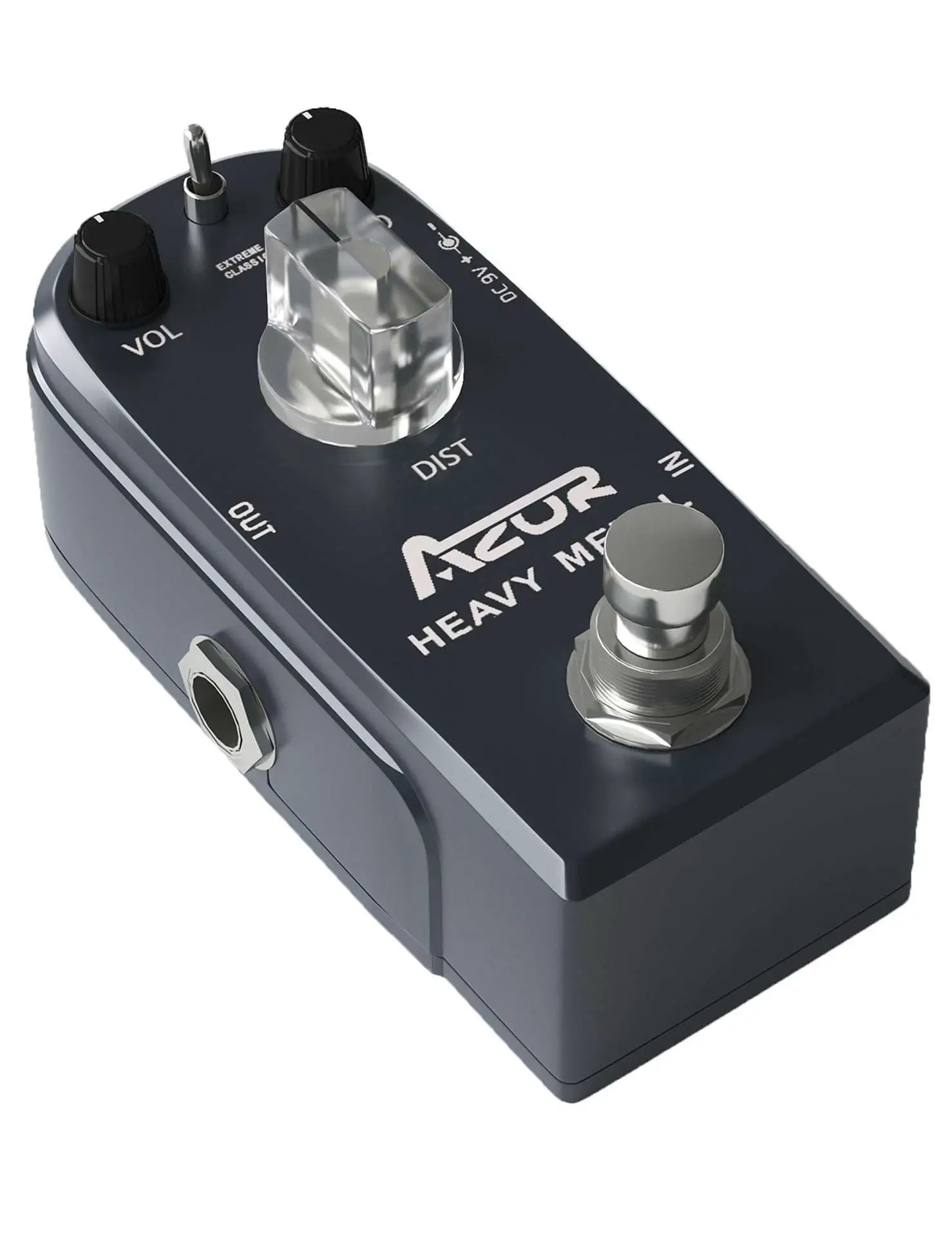
We believe the AZOR Heavy Metal Pedal is a solid choice for guitarists seeking that classic distortion without breaking the bank.
Pros
- True bypass keeps your tone intact
- Compact size fits any pedalboard
- Versatile tone-shaping with MID control
Cons
- No power adapter included
- Some may find the sound too compressed
- Limited to heavy metal and rock genres
The moment we plugged in the AZOR Heavy Metal Pedal, the room filled with an undeniable raw energy reminiscent of classic rock anthems. The pedal’s compact form factor surprised us with its weighty, durable feel, ensuring it could handle more than a few stomps. Even at high-gain settings, the true bypass technology preserved the integrity of our guitar’s original sound – a feature we don’t always find in pedals at this price point.
We dialed in settings that swept us from a tight, punchy classic distortion to a more modern, expansive tone with ease. The three-knob layout provided us with straightforward control to craft the sound in minute detail. Whether tweaking the volume, distortion, or mid frequencies, each adjustment made a distinct and musical change to the overall output.
However, our session wasn’t without a few caveats. Although the pedal performs well, it might not fit every genre, excelling predominantly within the realms of heavy metal and rock. Players seeking a broader spectrum of distortion flavors may want to look at other options. Additionally, having to source our own 9V power adapter meant one extra step before we could get playing. Despite this, the pros clearly outweighed the cons, making the AZOR Heavy Metal Pedal a pedalboard contender for those chasing a classic distortion journey.
Buying Guide
When we are in the market for the best distortion pedal, there are several features and considerations we need to keep in mind to ensure we make an informed choice. Let’s focus on the characteristics that define a quality distortion pedal.
Key Features to Consider
- Sound Quality: The primary consideration is the range of distortion available and how it complements our playing style. We look for clarity, warmth, and how the pedal responds to various guitar pickups.
- Durability: It must withstand regular use, so we check build quality and material.
- Ease of Use: Simple controls are preferable for quick adjustments during performances.
- Versatility: A pedal that offers multiple distortion types is useful for different genres.
Important Specifications
| Feature | Description |
|---|---|
| Gain Control | Allows for the adjustment of distortion intensity. |
| Tone Control | Modifies the color of the distorted signal. |
| Level Control | Balances the effect’s volume with the bypassed signal. |
| True Bypass | Preserves signal integrity when the pedal is off. |
Additional Considerations
- Connectivity: Consider the input and output options, ensuring they are compatible with our current setup.
- Power Requirements: We check whether the pedal uses batteries, an AC adapter, or both.
- Size: It should fit our pedalboard with ease and leave room for other effects.
By focusing on these features, we ensure that the distortion pedal we choose will be a reliable and valuable addition to our musical toolkit.
